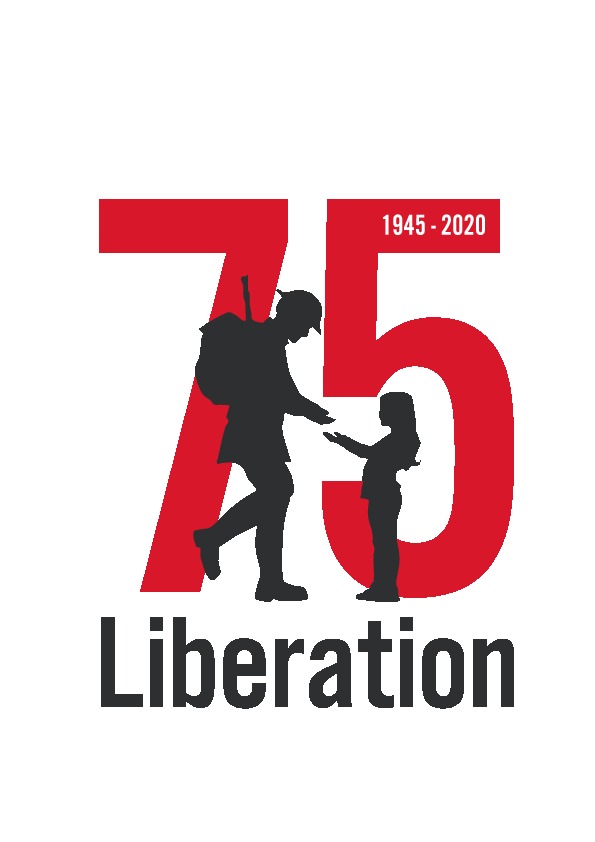But her granddaughter, Emma Le Gallais, a graphic designer in the government’s communications department, used the story as inspiration for her 75th anniversary logo, chosen from a number of other designs as the official emblem of the celebrations.
‘I think it’s the simplicity behind it that conveys a really poignant story,’ Mrs de Gruchy said.
‘I thought it was rather nice, but it’s much more than that; it’s handing the freedom down to the next generation. There are no frills or fancies about it – it is just that simplicity with the silhouettes and the dates.’
For Miss Le Gallais, the opportunity to submit a logo design was the latest in a series of projects going back to her school days, when family memories inspired a fascination with the Liberation.
‘I always grew up really interested in all the stories of Liberation, they always really intrigued me. It seems like a parallel world. I can’t ever imagine living under occupation or not having the everyday freedoms I take for granted. And since it’s from Jersey I found it so relevant, yet somehow so crazy,’ she said.
Her grandmother was just four on Liberation Day 1945, so memories of the day are – rather like her granddaughter’s design – snapshots rather than detailed stories. She travelled from the family small-holding in St Lawrence down to St Helier and remembers taking up a position on Victoria Avenue behind the railings of a garden to watch the liberating soldiers as they passed.
‘These strange men came along – the Tommies – they were handing out something in paper and, of course, we’d been told not to take anything from strangers, so we didn’t. But mum said “it’s OK, you can take it”. I’d never had a sweet before. That would possibly be my first memory. It was a very exciting day and you felt that excitement, even as a child,’ Mrs de Gruchy said.

Although too young to remember the detail of life under enemy occupation, she recalls visiting her father in Newgate Street jail, where he had been imprisoned by the Germans for giving food to a young Russian prisoner from the nearby Coin Varin camp.
‘One evening it was dark and my father went to answer the door. It was a young lad who had come to ask if he could eat some of the fodder in the yard because he was starving. They didn’t take him in, but dad said “go into the stable where it’s nice and warm with the cows”, and mum prepared something for him to eat. At the end of the war, when they marched the prisoners away, he broke away from the line to come and say thank you for saving his life. I’ve often wondered what happened to him since then.’
An informer passed information about the family on to the Germans and for this offence, and for holding more livestock than he was entitled to under the meticulous record-keeping of the occupiers, Mrs de Gruchy’s father was jailed.
‘To this day, if there’s a television programme with an old prison and you hear the sound of the clang of the prison door, I am transported back to Newgate Street,’ she said.
‘Those kind of fear things stay with you always.’
Mrs de Gruchy also remembers the extraordinary moment when her father, released from prison, appeared without warning at the front door in St Lawrence.
‘My mother was in the scullery and came through to answer the door. When she saw who it was, she fainted outright. You can imagine the tension she had within her, for she wasn’t a weak person but she had so much responsibility, worrying about what would have happened to the children and the animals, had she been taken prisoner herself.’
Distant memories of her earliest days during the Occupation become more concrete in the years that followed, when normal life returned to the Island and foodstuffs which had disappeared entirely reappeared to the amazement of children who had never seen such luxuries before.
‘There was a feeling of exhilaration once provisions started to come in. I’d never seen an orange or a banana. Mum had an orange and I’d never seen anything more beautiful – to this day an orange has never smelled so good. The closest I’ve come to tasting something so good was when my husband and I went to the Algarve where the oranges ripen on the tree, but it still wasn’t quite as good as that orange in Jersey. When mum started to peel it, I cried.
I thought you’re spoiling it,’ she remembers.
Mrs de Gruchy, who for many years ran a farm with her late husband Winter – son of a former Constable of St Martin, also called Winter – trained as a reflexologist and nutritionist when she was 50, and later became a Jèrriais teacher. She remains an adjudicator for the language at the Eisteddfod.
From her home in Beaumont, she relishes the opportunity to share the stories of Island life. The 75th anniversary of Liberation has additional significance thanks to Miss Le Gallais’s successful logo, which stands as a metaphor, as she puts it, for the wider sense of freedom which Jersey cherishes.
When her grandmother discovered the logo had been chosen from a number put forward, she was delighted.
‘I was emotionally moved and I just couldn’t believe it,’ Mrs de Gruchy said.
Unsurprisingly, both Miss Le Gallais and her grandmother are greatly looking forward to the 75th anniversary of the moment that the soldier handed down that simple wrapped sweet to a four-year-old child. There are no prizes for guessing where they will both be on 9 May.






